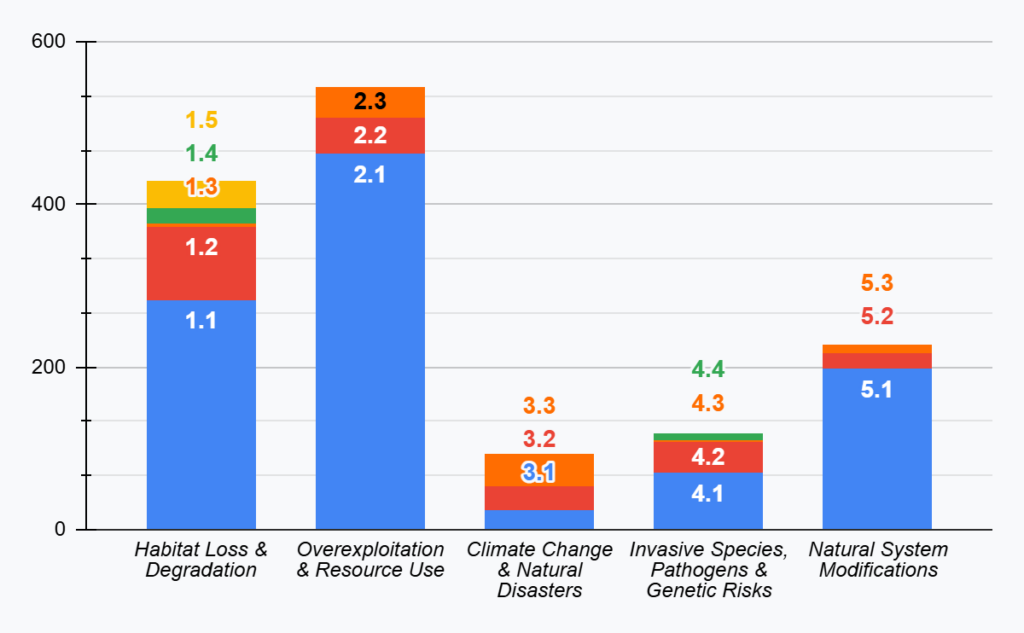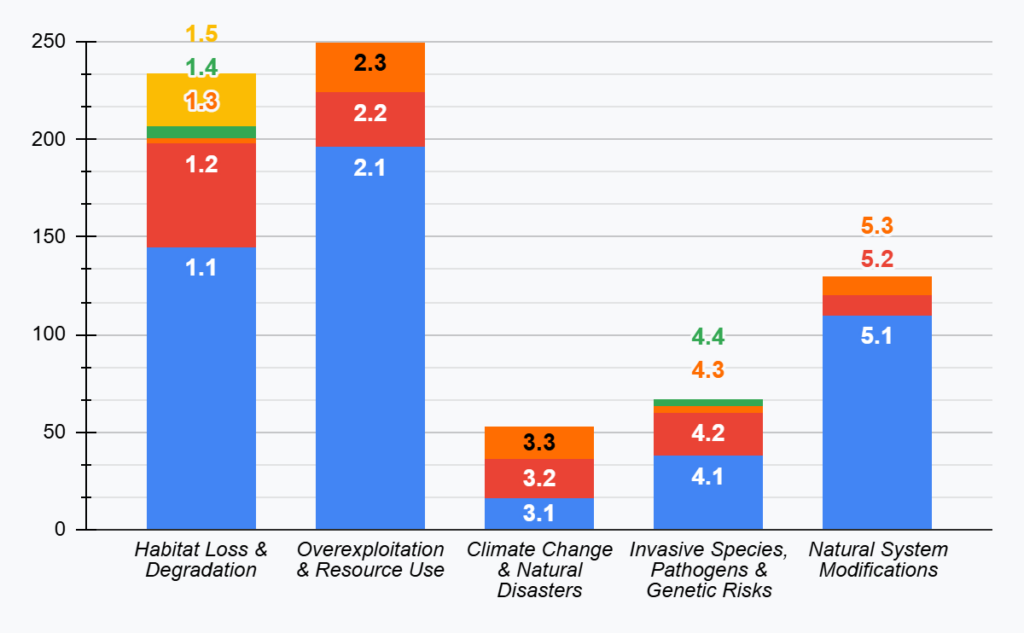Outline:
abstract
Introduction: new classification and analysis based on this classification.
Part 1: how was the new classification made
Part 2: what does this tell about conifer threats
Summary
The IUCN Red List has an extensive threats classification, specially designed to adequately cover a great many variety of threats. This classification is applicable to all living things; from coral to crustaceans, from ferns to fish. Because of this, some threats will not always be applicable, depending on what subsection of species you focus on. For this exact reason I decided to compress the broad classification and specialize it to just conifers. By this doing this, filtering conifers based on threats will be more intuitive and this makes it easier to analyze the threats conifers face.
My methadology was straight-forward: collect all threats UICN lists for conifer species, find redundancies and come up with a new structure to combine the more uncommon threats, while keeping roughly the same information.
The final result was a more information dense threat classification that can be used to more easily understand conifer threats, while keeping the main information. Below, the two classifications are put side-by-side. Beneath that, a collapsed menu can be found, indicating precisely which IUCN categories the restructured categories are made up of.
IUCN threat categories
- 1 Residential & commercial development
- 1.1 Housing & urban areas
- 1.2 Commercial & industrial areas
- 1.3 Tourism & recreation areas
- 2 Agriculture & aquaculture
- 2.1 Annual & perennial non-timber crops
- 2.2 Wood & pulp plantations
- 2.3 Livestock farming & ranching
- 3 Energy production & mining
- 3.2 Mining & quarrying
- 3.3 Renewable energy
- 4 Transportation & service corridors
- 4.1 Roads & railroads
- 5 Biological resource use
- 5.1 Hunting & trapping terrestrial animals
- 5.2 Gathering terrestrial plants
- 5.3 Logging & wood harvesting
- 5.4 Fishing & harvesting aquatic resources
- 6 Human intrusions & disturbance
- 6.1 Recreational activities
- 6.2 War / civil unrest & military exercises
- 7 Natural system modifications
- 7.1 Fire & fire suppression
- 7.2 Dams & water management/use
- 7.3 Other ecosystem modificatons
- 8 Invasive and other problematic species / genes & diseases
- 8.1 Invasive non-native/alien species/diseases
- 8.2 Problematic native species/diseases
- 8.3 Introduced genetic material
- 8.4 Problematic species/disease of unknown origin
- 8.6 Diseases of unknown cause
- 9 Pollution
- 9.1 Domestic & urban waste water
- 9.2 Industrial & military effluents
- 9.5 Air-borne pollutants
- 10 Geological events
- 10.1 Volcanoes
- 10.2 Earthquakes/tsunamis
- 10.3 Avalanches/landslides
- 11 Climate change & severe weather
- 11.1 Habitat shifting & alteration
- 11.2 Droughts
- 11.3 Temperature extremes
- 11.4 Storms & flooding
- 11.5 Other impacts
- 12 Other options
- 12.1 Other threat
Restructured threat categories
- 1 Habitat Loss & Degradation
- 1.1 Agriculture & Forestry
- 1.2 Urban & Infrastructure Development
- 1.3 Renewable Energy Development
- 1.4 Air / Soil & Water Pollution
- 1.5 Direct Human Disturbance
- 2 Overexploitation & Resource Use
- 2.1 Logging & Wood Harvesting
- 2.2 Biological Resource Use
- 2.3 Mining & Quarrying
- 3 Climate Change & Natural Disasters
- 3.1 Drought & Temperature Extremes
- 3.2 Storms / Flooding & Other Events
- 3.3 Habitat Shifting & Alteration
- 4 Invasive Species / Pathogens & Genetic Risks
- 4.1 Invasive Non-Native Species & Diseases
- 4.2 Problematic Native Species & Diseases
- 4.3 Diseases of Unknown Origin
- 4.4 Genetic Contamination & Hybridization
- 5 Natural System Modifications
- 5.1 Fire & Fire Suppression
- 5.2 Water Management & Dams
- 5.3 Other Ecosystem Modifications
The restructured classification referencing the old categories in brackets (click to reveal).
- 1 Habitat Loss & Degradation
- 1.1 Agriculture & Forestry
- (IUCN 2.1, 2.2, 2.3)
- 1.2 Urban & Infrastructure Development
- (IUCN 1.1, 1.2, 1.3, 4.1)
- 1.3 Renewable Energy Development
- (IUCN 3.3)
- 1.4 Air, Soil & Water Pollution
- (IUCN 9.1, 9.2, 9.5)
- 1.5 Direct Human Disturbance
- (IUCN 6.1, 6.2)
- 1.1 Agriculture & Forestry
- 2 Overexploitation & Resource Use
- 2.1 Logging & Wood Harvesting
- (IUCN 5.3)
- 2.2 Biological Resource Use
- (IUCN 5.1, 5.2, 5.4)
- 2.3 Mining & Quarrying
- (IUCN 3.2)
- 2.1 Logging & Wood Harvesting
- 3 Climate Change & Natural Disasters
- 3.1 Drought & Temperature Extremes
- (IUCN 11.2, 11.3)
- 3.2 Storms, Flooding & Other Events
- (IUCN 11.4, 11.5, 10.1, 10.2, 10.3)
- 3.3 Habitat Shifting & Alteration
- (IUCN 11.1)
- 3.1 Drought & Temperature Extremes
- 4 Invasive Species, Pathogens & Genetic Risks
- 4.1 Invasive Non-Native Species & Diseases
- (IUCN 8.1)
- 4.2 Problematic Native Species & Diseases
- (IUCN 8.2)
- 4.3 Diseases of Unknown Origin
- (IUCN 8.4, 8.6)
- 4.4 Genetic Contamination & Hybridization
- (IUCN 8.3)
- 4.1 Invasive Non-Native Species & Diseases
- 5 Natural System Modifications
- 5.1 Fire & Fire Suppression
- (IUCN 7.1)
- 5.2 Water Management & Dams
- (IUCN 7.2)
- 5.3 Other Ecosystem Modifications
- (IUCN 7.3)
- 5.1 Fire & Fire Suppression
On all pages of database entries for species found on this website (found under: Just Species), you can find information about conifer threats. It uses the reclassified threat categories based on the threats data provided by the IUCN Red List. Amongst the database filters, there is also the possibility to filter species based on main threats and sub threats.
Now that a reclassification has been made, the conifer threats can be explored further by analyzing the number of conifers associated with the threats and the nature of the threats. Threats can be caused by for instance natural phenomena, sheer chance or they can be caused by humans. In case of a human cause, it adds to the necessity to raise attention for this.
To further understand the nature of conifer threats, a bar chart for all main threats has been obtained from the number of conifers associated to all individual sub threats. Listed below is the chart obtained and form this, it’s apparent what threats are more common than others.

Number of conifers associated with restructured threat categories. Colours indicate individual threats and their corresponding numbers refer to the restructured threat classification. Total number for each bar is cumulative, therefore almost certainly contains duplicate conifers.
According to this chart, the most common threats to all conifers in decreasing order are:
- 2.1 Logging & Wood harvesting
- 1.1 Agriculture & Forestry
- 5.1 Fire & Fire Suppression
And the main threats can be ordered by significance:
- 2 Overexploitation & Resource Use
- 1 Habitat loss & Degradation
- 5 Natural System Modifications
- 4 Invasive Species, Pathogens & Genetic Risks
- 5 Climate Change & Natural Disasters
This dataset includes conifers that are not strictly “Threatened Conifers”. This sounds unintuitive, but this means that conifers which do not have a IUCN status of “Critically Endangered” , “Endangered” or “Vulnerable” (being a “Threatened Conifer”), can still face threats, although it does not threaten the total population in a disastrous way. You can read more about this in the course The IUCN Red List. Listed below is the chart obtained from solely conifers labelled as “Threatened”.

Number of “Threatened” conifers associated with restructured threat categories. Colours indicate individual threats and their corresponding numbers refer to the restructured threat classification. Total number for each bar is cumulative, therefore almost certainly contains duplicate conifers.
Interestingly, not a whole lot of changes can be observed. The relative
